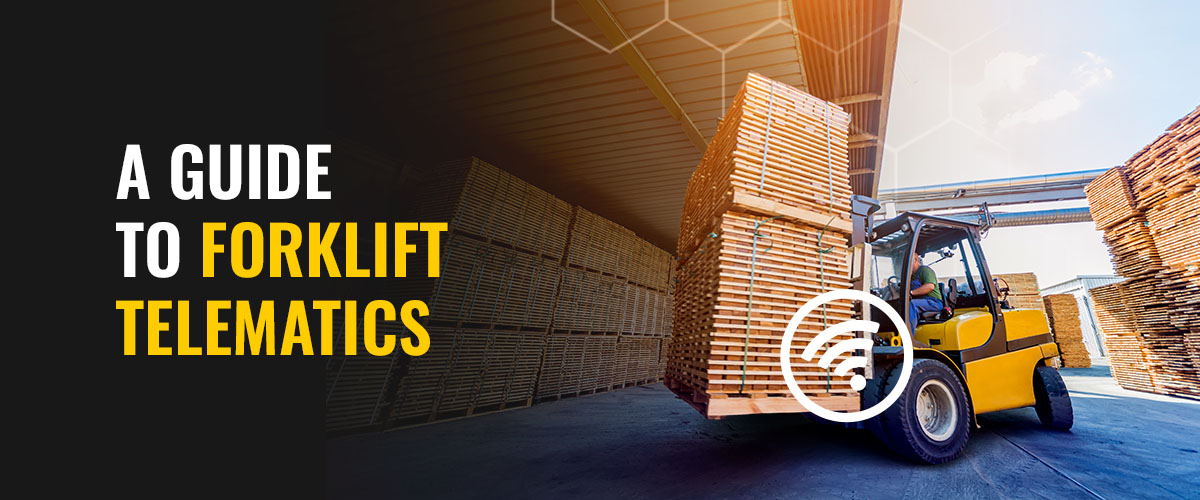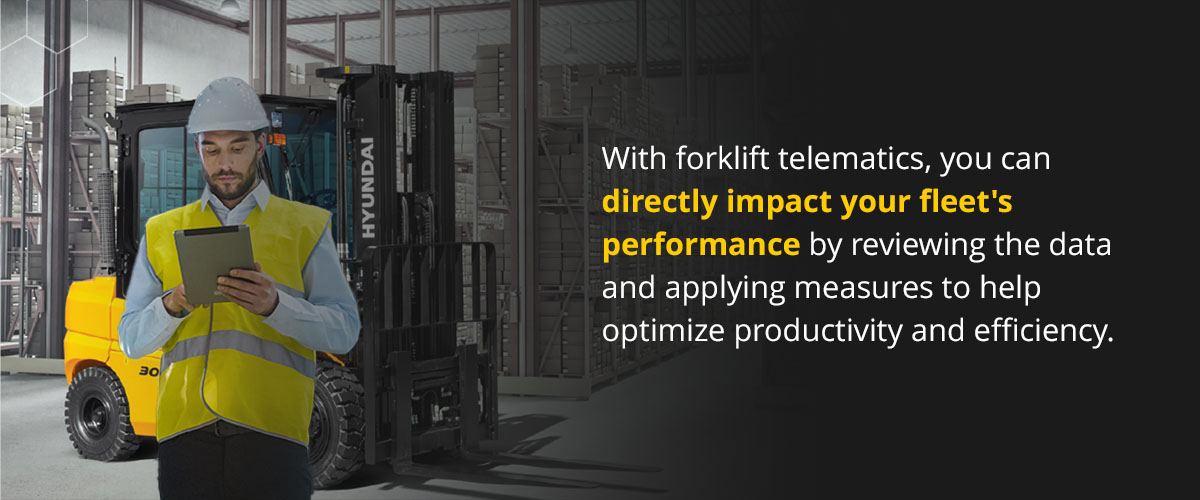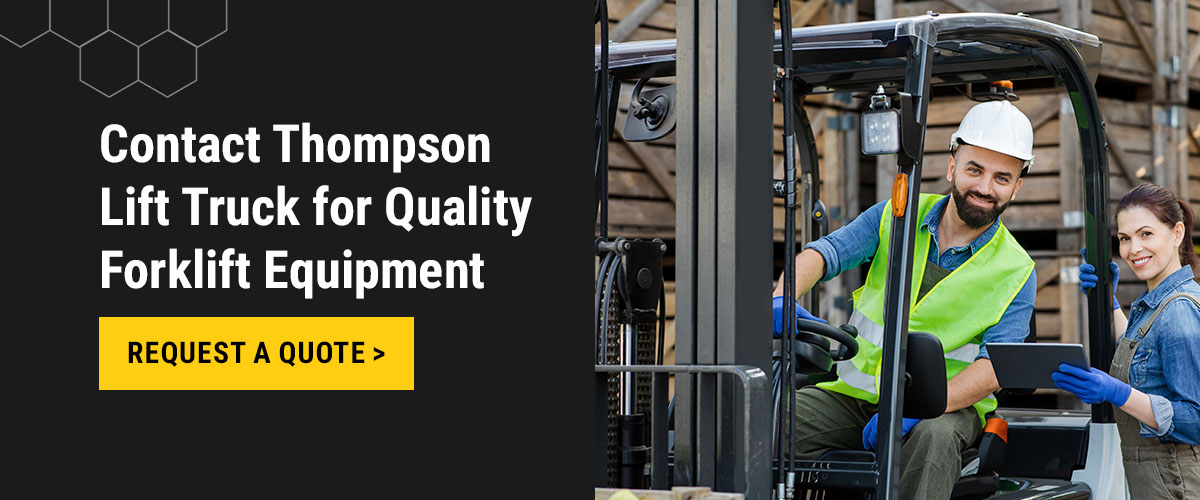
A Guide to Forklift Telematics

Forklift telematics enables smooth fleet management and material handling. In recent years, these systems have undergone technological advances, providing forklift owners and operators with many advantages, with greater efficiency at the forefront. If you’re looking to transform your fleet, telematics is key to creating a more productive operational landscape.
What Is Telematics?
Telematics delivers an operator or fleet manager with information about the forklift’s performance, speed, positioning, trip distance, fuel consumption, battery level, braking pressure, and other safety-related details. The system obtains this information by incorporating telecommunications and information processing technology. As a result, operators can remotely control and monitor vehicles.
Devices fitted on the forklift, along with a telematics instrument, collect data, and the collected data is sent to, stored, and accessed on a central server. Teams can review and interpret the data to determine the vehicle’s state and use it to plan and preempt maintenance and repairs. With this fleet tracking system, you can save by identifying areas of operational improvement, whether with fuel efficiency or by enhancing driving skills.
Why Is Telematics Beneficial?
There are a few key benefits of telematics for forklifts, including:
Cost Savings and Improvements
The transparency and ease of acquiring the necessary information help you understand how your fleet is being utilized. For example, knowing whether an operator is driving too hard or too fast and thus using fuel excessively will enable you to encourage better driving practices. With this, fuel consumption should improve. Monitoring the battery level and other operational parts allows you to assess the vehicle for potential damage and arrange service or repairs.
These measures will save you on fuel and maintenance costs in the long run and improve cost efficiency through preventative maintenance and repairs.
Increased Safety Considerations
Forklift telematics helps increase safety awareness for operators and pedestrians. Here are a few safety considerations to keep in mind:
- Telematics provides you with the required data to implement stringent safety measures to keep your fleet and operators secure.
- Incorporating artificial intelligence (AI) into the telematics system helps detect operator fatigue and reduce the risk of being distracted while driving.
- Speed can be monitored and controlled to ensure the operator stays within reasonable limits.
- Increased forklift safety innovations promote the use of sensors to detect people and objects to avoid accidents.
- Some telematics systems require a pre-operational check before operators can drive the forklift, which helps detect issues before starting up.
- Regular safety training for operators and staff will ensure everyone is on par with safety standards and comply with regulations.
- Specially trained and authorized operators will only be allowed to access forklifts to reduce liability for co-workers.
- Frequently updating the telematics system and warehouse management software to ensure they’re in sync will promote efficiency.
Improved Productivity and Efficiency
With forklift telematics, you can directly impact your fleet’s performance by reviewing the data and applying measures to help optimize productivity and efficiency. This automated process saves time and money that would have been spent collecting the same information manually by physical inspections. The forklift’s life span also increases when used correctly due to reduced maintenance requirements.
Telematics for Forklifts
Material handling is easier with an effective forklift telematics system. Managing your fleet through remote monitoring helps control the material handling process.
Using telematics, trained operators scan in before their shifts, giving you access to their activities while driving. You can assess how fast they drive, how often they stop, how hard they brake, and how they consume fuel through each action while operating the forklift. With real-time feedback on the vehicles, you can determine operator efficiency and devise strategies for improved workflow.
The forklift is monitored for battery life and alerts you to recharge time frames based on idle time. Further reports on system malfunctions and errors are available to help diagnose issues before they worsen. This aids in implementing preventative maintenance measures to keep the fleet in working condition.
Forklift telematics ensures seamless fleet management for optimal material handling and worker productivity.
What Is the Future of Forklift Telematics Systems?
Forklift telematics systems offer numerous prospects for the future you should be aware of for your operations:
1. Enhanced Safety Features and Ergonomic Designs
In the future, we can expect enhanced features that put the safety of operators and staff first. These include sensors that detect people and slow down when approaching busy intersections. Cameras and lighting will help guide operators, especially when visibility is poor in certain parts of the warehouse and at night.
Further ergonomic features will ensure operators aren’t distracted or prone to falling asleep behind the wheel. Most forklifts will or already include load-bearing and stability sensors that ensure an even weight-load distribution to prevent them from toppling over. This keeps the driver and surroundings secure.
2. Artificial Intelligence Integration and Autonomous Navigation
AI integration into telematics systems will help managers assess the operator’s physical capacity through facial recognition and vital assessment before they drive. It can detect fatigue and other elements that could potentially pose a risk. AI may be as advanced as enabling remote navigation, reducing the need for operators, and increasing productivity through constant availability.
3. Effective System Integration
Telematics systems can be integrated with the current warehouse management system and Internet of Things tools. Combined, these systems will optimize the features and functionality of both to maximize efficiency.
4. Enhanced Machine Learning Capabilities
With advances in machine learning technology, telematics forklifts could be exposed to algorithms and AI-integrated systems that will help with self-sustainability. It will promote driverless navigation, independent task and material handling, monitor functions, and alert managers to system issues before they are flagged.
5. Improved Sustainability and Energy Efficiency
New or used electric forklifts with lithium-ion batteries benefit the environment. Lithium batteries are rechargeable and can be used at length before being recharged. They are also safer to dispose of. The future of forklift telematics includes optimizing energy. This is done by providing data on the vehicle’s fuel consumption and battery usage to maximize performance while reducing carbon emissions, contributing to a sustainable environment.
Contact Thompson Lift Truck for Quality Forklift Equipment
Managing a forklift fleet doesn’t have to be hard. Telematics systems have been developed to help improve efficiencies while saving costs and enhancing safety. Thompson Lift Truck has an array of suitable forklifts for various applications, new and used. You can trust our years of experience to help you find the right forklift and other machinery for your needs.
Call us at 833-937-3682 with your equipment requirements, or get a quote on any of our forklifts today.


